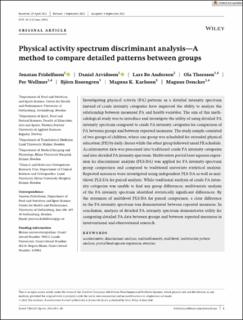| dc.contributor.author | Fridolfsson, Jonatan | |
| dc.contributor.author | Arvidsson, Daniel | |
| dc.contributor.author | Andersen, Lars Bo | |
| dc.contributor.author | Thorsson, Ola | |
| dc.contributor.author | Wollmer, Per | |
| dc.contributor.author | Rosengren, Björn | |
| dc.contributor.author | Karlsson, Magnus K. | |
| dc.contributor.author | Dencker, Magnus | |
| dc.coverage.spatial | Sweden, Malmö | en_US |
| dc.date.accessioned | 2021-11-12T13:18:38Z | |
| dc.date.available | 2021-11-12T13:18:38Z | |
| dc.date.created | 2021-10-04T20:27:14Z | |
| dc.date.issued | 2021 | |
| dc.identifier.citation | Fridolfsson, J., Arvidsson, D., Andersen, L. B., Thorsson, O., Wollmer, P., Rosengren, B., Karlsson, M. K., & Dencker, M. (2021). Physical activity spectrum discriminant analysis—A method to compare detailed patterns between groups. Scandinavian Journal of Medicine & Science in Sports, 31(12), 2333-2342. | en_US |
| dc.identifier.issn | 0905-7188 | |
| dc.identifier.uri | https://hdl.handle.net/11250/2829371 | |
| dc.description.abstract | Investigating physical activity (PA) patterns as a detailed intensity spectrum instead of crude intensity categories have improved the ability to analyze the relationship between measured PA and health variables. The aim of this methodological study was to introduce and investigate the utility of using detailed PA intensity spectrum compared to crude PA intensity categories for comparison of PA between groups and between repeated measures. The study sample consisted of two groups of children, where one group was scheduled for extended physical education (PE) by daily classes while the other group followed usual PE schedule. Accelerometer data was processed into traditional crude PA intensity categories and into detailed PA intensity spectrum. Multivariate partial least squares regression for discriminant analysis (PLS-DA) was applied for PA intensity spectrum group comparison and compared to traditional univariate statistical analysis. Repeated measures were investigated using independent PLS-DA as well as multilevel PLS-DA for paired analysis. While traditional analysis of crude PA intensity categories was unable to find any group differences, multivariate analysis of the PA intensity spectrum identified statistically significant differences. By the extension of multilevel PLS-DA for paired comparison, a clear difference in the PA intensity spectrum was demonstrated between repeated measures. In conclusion, analysis of detailed PA intensity spectrum demonstrates utility for comparing detailed PA data between groups and between repeated measures in interventional and observational research. | en_US |
| dc.language.iso | eng | en_US |
| dc.publisher | Wiley | en_US |
| dc.rights | Attribution-NonCommercial-NoDerivatives 4.0 Internasjonal | * |
| dc.rights.uri | http://creativecommons.org/licenses/by-nc-nd/4.0/deed.no | * |
| dc.subject | accelerometer | en_US |
| dc.subject | discriminant analysis | en_US |
| dc.subject | multicollinearity | en_US |
| dc.subject | multilevel | en_US |
| dc.subject | multivariate pattern analysis | en_US |
| dc.subject | partial least squares regression | en_US |
| dc.subject | statistics | en_US |
| dc.title | Physical activity spectrum discriminant analysis—A method to compare detailed patterns between groups | en_US |
| dc.type | Peer reviewed | en_US |
| dc.type | Journal article | en_US |
| dc.description.version | publishedVersion | en_US |
| dc.rights.holder | © 2021 The Authors | en_US |
| dc.subject.nsi | VDP::Samfunnsvitenskap: 200::Samfunnsvitenskapelige idrettsfag: 330::Aktivitetslære: 332 | en_US |
| dc.source.pagenumber | 2333-2342 | en_US |
| dc.source.volume | 31 | en_US |
| dc.source.journal | Scandinavian Journal of Medicine & Science in Sports | en_US |
| dc.source.issue | 12 | en_US |
| dc.identifier.doi | 10.1111/sms.14052 | |
| dc.identifier.cristin | 1943192 | |
| cristin.ispublished | true | |
| cristin.fulltext | original | |
| cristin.qualitycode | 2 | |

